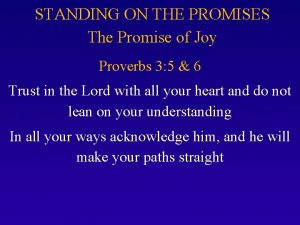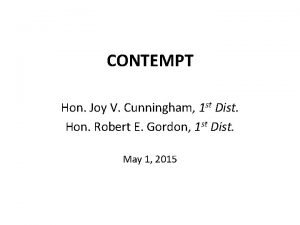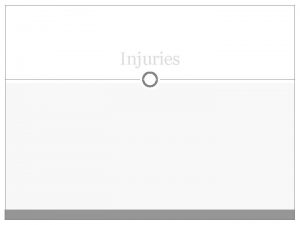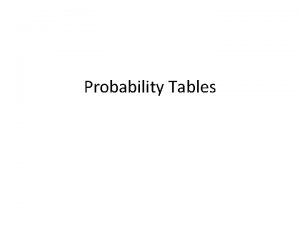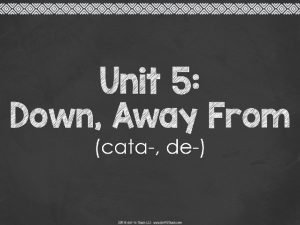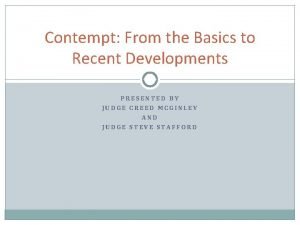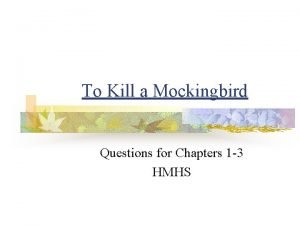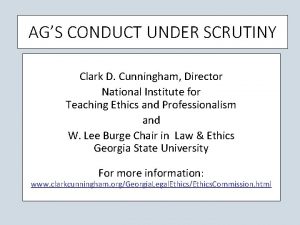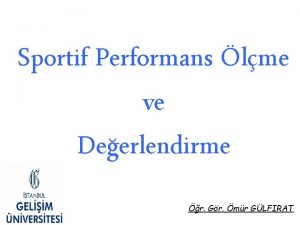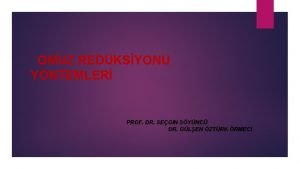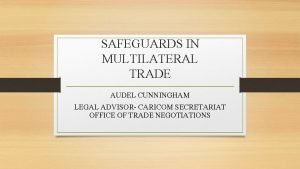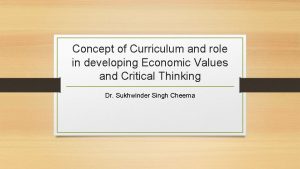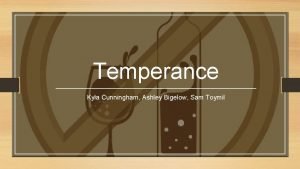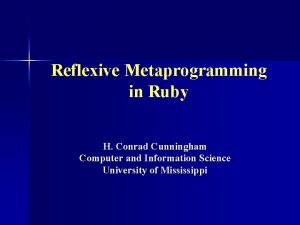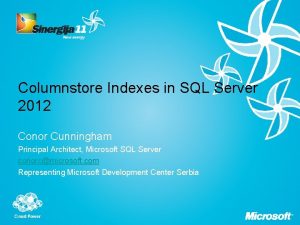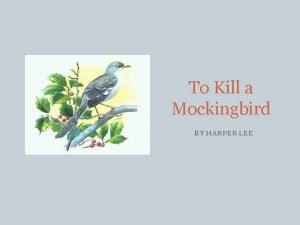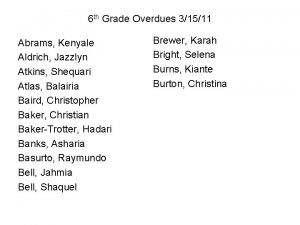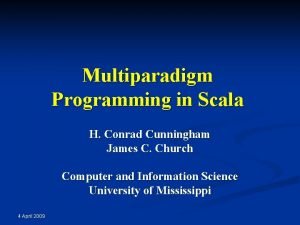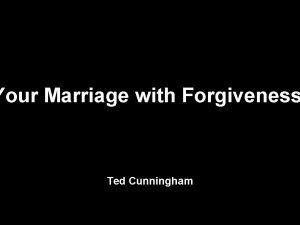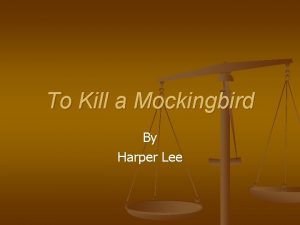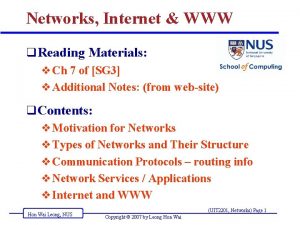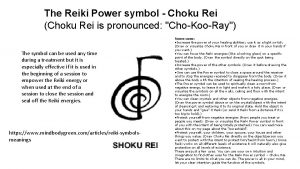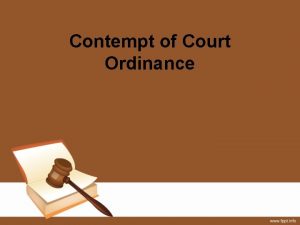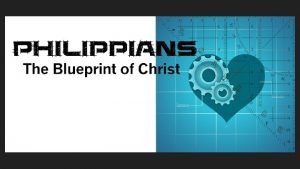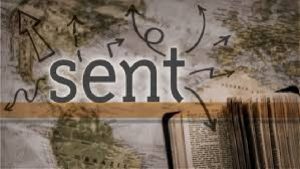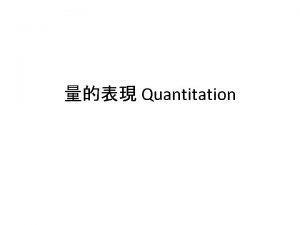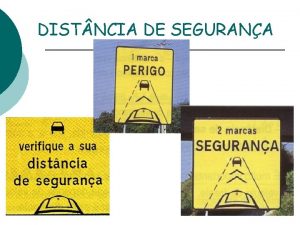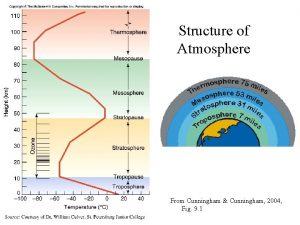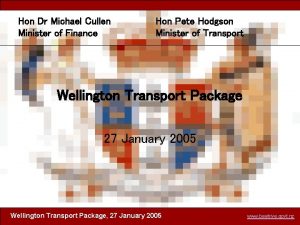CONTEMPT Hon Joy V Cunningham 1 st Dist













![Direct Civil Contempt • Alleged Contemnor (AC) must willfully disobey a [valid] court order Direct Civil Contempt • Alleged Contemnor (AC) must willfully disobey a [valid] court order](https://slidetodoc.com/presentation_image_h/ff0344521f1d5e27d1f4df2c566f642d/image-14.jpg)




















- Slides: 34

CONTEMPT Hon. Joy V. Cunningham, 1 st Dist. Hon. Robert E. Gordon, 1 st Dist. May 1, 2015

Use contempt as a last resort, whenever possible 2

After this session, participants will: • Learn Strategies for Avoiding Contempt • • Findings Effectively Distinguish between Civil and Criminal Contempt; Tackle the Nuts and Bolts of Civil Contempt; Recognize Effective Civil Contempt Orders; Better understand the Application and Issues of the Debtors’ Rights Act of 2012 3

“The power of the court to punish for contempt does not depend on constitutional or legislative grant, but is inherent in all courts as essential to the proper and effective functioning of the courts and to the administration of justice. ” 47 th & State Currency Exchange v. Coleman Corp. , 56 Ill. App. 3 d 229, 233 (1 st Dist. 1977) 4

The types of sanctions and whether to impose sanctions lie within the sound discretion of the court. Multituit Corp v. Draiman, Ill. App. 3 d 527 (1 st Dist. 2005) 359 5

Criminal Contempt 1. To punish 2. Constitutional protections that are allowed to all criminal defendants, and for indirect contempt: - Right to a jury trial when incarceration exceeds 6 months or the fine exceeds $500. 00 - Right to counsel - Right to change of judge - Right to be charged with a written complaint, petition, or information 6

Criminal Contempt (cont. ) - Right to file an answer and have a public trial - Right to present evidence, subpoena witnesses, and to confront and crossexamine witnesses - Right to the presumption of innocence and against self-incrimination - Right to be proven guilty beyond a reasonable doubt 3. The sanction must be retrospective – a punishment for doing what has been prohibited. 7

Civil Contempt 1. To compel compliance with court orders 2. Prospective: the sanction for refusing to do what has been ordered 3. Limited constitutional protections The contemnor has the right to…. - to be advised of contumacious conduct - to receive a copy of the written order - to make a statement prior to sanctions 8

Civil Contempt (cont. ) 4. Defense: inability to perform 5. Contemnor must have the ability to purge 6. All fines payable to the Clerk of the Court 7. Additional remedies as provided by statute 9

What kind of contempt? Ask, “What is the court attempting to accomplish? ” • If punishing Criminal • If compelling conduct Civil • If punishing and compelling Criminal and Civil 10

CIVIL v. CRIMINAL CONTEMPT Civil Contempt Criminal Contempt - Failure to perform an act ordered by the court - Purpose: To Direct compel and act Sanction: or Prospective Indirect - Fewer Constitutional protections - Behavior that assaults the dignity or impairs the ability of the court to conduct its work - Purpose: Punish - Sanction: Retrospective - Constitutional protections provided

CIVIL v. CRIMINAL CONTEMPT (cont. ) Civil Contempt Criminal Contempt - Separate cause of - Same as original action (separate Direct cause of action case number) or - Requires written order Indirect order - Right to Appeal

Direct v. Indirect Contempt • Both civil and criminal contempt can be direct or indirect. • Direct contempt is an act that occurs in the presence, or constructive presence, of the court - the judge must hear or see the act. • Indirect contempt occurs in whole or part outside the presence of the court. 13
![Direct Civil Contempt Alleged Contemnor AC must willfully disobey a valid court order Direct Civil Contempt • Alleged Contemnor (AC) must willfully disobey a [valid] court order](https://slidetodoc.com/presentation_image_h/ff0344521f1d5e27d1f4df2c566f642d/image-14.jpg)
Direct Civil Contempt • Alleged Contemnor (AC) must willfully disobey a [valid] court order in the presence or constructive presence of the Court • Examples: Alleged Contemnor (AC) refuses to appear/testify under a valid subpoena, refuses to submit to fingerprints, turn over paycheck stubs, etc. • Judge must: Give AC notice of contumacious act; opportunity to make a statement; a copy of the written order giving the AC the ability to purge (“keys to his cell”) • Defense: Inability to perform, valid 5 th Amend’t claim 14

Indirect Civil Contempt • Commonly instituted by a Petition for Rule to Show Cause (to enforce compliance) • Usually brought by a party to the original action • The AC is afforded limited Due Process Rights • Notice must contain an adequate description of the facts and give the time and place of the evidentiary hearing 15

Indirect Civil Contempt (cont. ) • The burden of proof is on the petitioner to prove by a preponderance of the evidence (1)that respondent willfully (2) violated a [valid] court order • Then, the respondent must show failure to comply was not willful or contemptuous 16

Scenario 1 AVOIDING CONTEMPT FINDINGS The judge rules in favor of the plaintiff, the defendant then turns to his attorney and makes a disparaging racial or ethnic remark about the judge to his attorney, which the judge overhears. Is this contempt? What type? 17

Scenario 2 AVOIDING CONTEMPT FINDINGS In a divorce case, the trial court disqualifies an attorney who disagrees with the decision and refuses to leave the bench after another case is called. Is the lawyer out of bounds? In re Marriage of Newton, 955 N. E. 2 nd 572 (Ill. App. 2011) 18

Scenario 3 AVOIDING CONTEMPT FINDINGS In the jury selection process, a member of the venire refuses to answer any questions and refuses to even verify her address. Is this venire person subject to contempt? 19

Elements of Civil Contempt (1) A valid court order requiring the contemnor to do something; (2) Contemnor is able to perform the action demanded; (3) The contemnor refuses to perform the action demanded; (4) No further civil sanctions are imposed if the contemnor complies; and (5) The contempt order provides a means for the contemnor to purge the contempt finding. NOTE: While the contemnor’s intent is irrelevant, the inability to perform is a defense (so long as the infeasibility is not caused by the contemnor). 20

Cannot Be Civil Contempt Unless There Is an Ability to Purge Failure to comply with a court's order can result in a finding of civil contempt. When the order is complied with, the contempt is purged.

Civil Contempt: Coercive Force • Civil contempt loses coercive force • If you have indefinite order of committement to imprison until someone does something it loses its coercive force • The contemnor bears the burden of demonstrating that the sanction has lost its coercive force and will not likely cause him to comply with the order of the court. • A contemnor’s avowed refusal to comply with the order is one circumstance that a court may consider in determining whether a sanction for civil contempt remains coercive. 22

Civil Contempt: Coercive Force (cont. ) • Other criteria that a court may consider in making this determination include the age and health of contemnor, the length of incarceration, and the “significance of the ends to be achieved” by the underlying order. 23

Writing Effective Civil Contempt Orders The judgment order in direct civil contempt proceedings must: (1) Be in writing (an orally transmitted order of contempt is not sufficient notice); (2) Signed by the judge; (3) Show jurisdiction over the parties and subject matter; (4) Set forth the specific act or acts for which the contemnor is being held in contempt and the grounds supporting the finding of contempt; 24

Writing Effective Civil Contempt Orders (cont. ) (5) When involving the failure to pay child support or a money judgment, the order must contain a finding that contemnor’s failure to comply with the order was willful and the contemnor has means to comply but refuses to do so; (NOTE: willfulness and intent are not issues in a violation of an injunctive order. ) (6) Provide sanctions; 25

Writing Effective Civil Contempt Orders (cont. ) (7)Set forth means by which the contemnor may purge the contempt; (8)Include in its decretal portion, a description of adjudication and sanctions imposed; (9)Order must be immediately transmitted to the contemnor and the jailer along with the commitment order, when applicable. 26

Scenario 4 CIVIL CONTEMPT During a personal injury case, plaintiff's attorney informs the trial court that a medical doctor who treated plaintiff was subpoenaed a month ago and informed him one hour ago that he refuses to appear at the trial. Or a police officer who came to the scene or a witness fails to appear. As a trial lawyer, what relief would you request? 27

Scenario 5 An eviction judge ordered the sheriff to evict a person by a date certain after becoming frustrated by the sheriff's actions over time. The sheriff did evict the person but not before the date set by the court. Plaintiff's lawyer filed a rule to show cause as to why the sheriff should not be held in contempt of court. After a hearing, the trial court found the sheriff in civil contempt and entered a fine of $1, 400. 00, payable to plaintiff for their rent loss, and $3, 093. 75 for attorney's fees. Was the trial court correct? SKS and Associates, Inc. v. Dart, 2012 IL App. (1 st) 103504 28

Scenario 6 Valerie was a speeding ticket defendant who, during a recess outside of a courtroom, was overheard by the court bailiff saying, "I waited all f***ing morning and now she takes a break. " The bailiff told the judge. The judge returned to the bench and instructed the State to prepare and file a petition for contempt and refused to give the defendant a continuance. After an immediate hearing, the judge sentenced defendant to eight days in jail. 1. Is this civil or criminal contempt? 2. Is this direct or indirect contempt? 3. Did the judge do anything wrong? People v. Perez, 2014 IL App (3 d) 120978 29

Scenario 7 A defendant, after a jury trial for domestic battery, was found unfit to stand trial. During his trial, he made repeated outbursts accusing the court of being "thugs, " "playing games, " and other improper phrases, and continually interrupted the court during the trial. The court found the defendant in contempt and initially sentenced him to consecutive six-month terms in jail. 1. Is this a valid contempt finding? 2. Can the court sentence the defendant to consecutive terms in prison? People v. Hodge, 2014 IL App (3 d) 120720 -U 30

ILLINOIS CONSTITUTION ARTICLE I, SECTION 14 "No person shall be imprisoned for debt unless he refuses to deliver up his estate for the benefit of his creditors as provided by law or unless there is a strong presumption of fraud. No person shall be imprisoned for failure to pay a fine in a criminal case unless he has been afforded adequate time to make payment, in installments of necessary, and has willfully failed to make a payment. " Ill. Const. 1970, Art. I, § 14. 31

Debtors' Rights Act of 2012 "No order of body attachment or other civil order for the incarceration or detention of a natural person respondent to answer for a charge of indirect civil contempt shall issue unless the respondent has first had an opportunity, after personal service or abode service of notice as provided in Supreme Court Rule 105, to appear in court to show cause why the respondent should not be held in contempt. " 735 ILCS 5/12 -107. 5 32

The Act was amended effective January 1, 2014 - does not apply to: the enforcement of any order or judgment resulting from an adjudication of a municipal ordinance violation that is subject to Supreme Court Rules 570 through 579, or from an administrative adjudication of such an ordinance violation – or the enforcement of any order or judgment for child support 33

Why the Debtor's Rights Act of 2012 • Different procedures in different jurisdictions • Efforts to create uniformity • Special issues – areas yet unsettled: 34
 If you want joy real joy wonderful joy
If you want joy real joy wonderful joy Joy cunningham
Joy cunningham Joy to the world unspeakable joy
Joy to the world unspeakable joy Laesio interna genus
Laesio interna genus Probability table
Probability table Treat someone with contempt
Treat someone with contempt Number the stars vocabulary
Number the stars vocabulary Civil contempt
Civil contempt To kill a mockingbird chapter 1-6 summary
To kill a mockingbird chapter 1-6 summary What happens in chapter 2 of to kill a mockingbird
What happens in chapter 2 of to kill a mockingbird Dr sarah cunningham
Dr sarah cunningham Clark d cunningham
Clark d cunningham Rockport yürüyüş testi
Rockport yürüyüş testi Cunningham tekniği
Cunningham tekniği Audel cunningham
Audel cunningham Cunningham curriculum definition
Cunningham curriculum definition Kyla cunningham
Kyla cunningham Conrad cunningham
Conrad cunningham Claude cunningham
Claude cunningham Cunningham
Cunningham Statistics sample rates conor cunningham
Statistics sample rates conor cunningham Soft taffeta-like sounds
Soft taffeta-like sounds Dr elizabeth cunningham
Dr elizabeth cunningham Breanna cunningham robert abrams
Breanna cunningham robert abrams Conrad cunningham
Conrad cunningham Cecilia cunningham
Cecilia cunningham Ted cunningham marriage
Ted cunningham marriage Frances cunningham finch
Frances cunningham finch Hon doc rock hill
Hon doc rock hill Con xin tiến dâng rượu bánh nơi nương đồng
Con xin tiến dâng rượu bánh nơi nương đồng Nicest
Nicest Leong hon wai
Leong hon wai Kìa nhìn xem trên kia có cái con chi to ghê
Kìa nhìn xem trên kia có cái con chi to ghê Mẹ đứng đó khi hoàng hôn tím màu
Mẹ đứng đó khi hoàng hôn tím màu Rei ticker symbol
Rei ticker symbol
